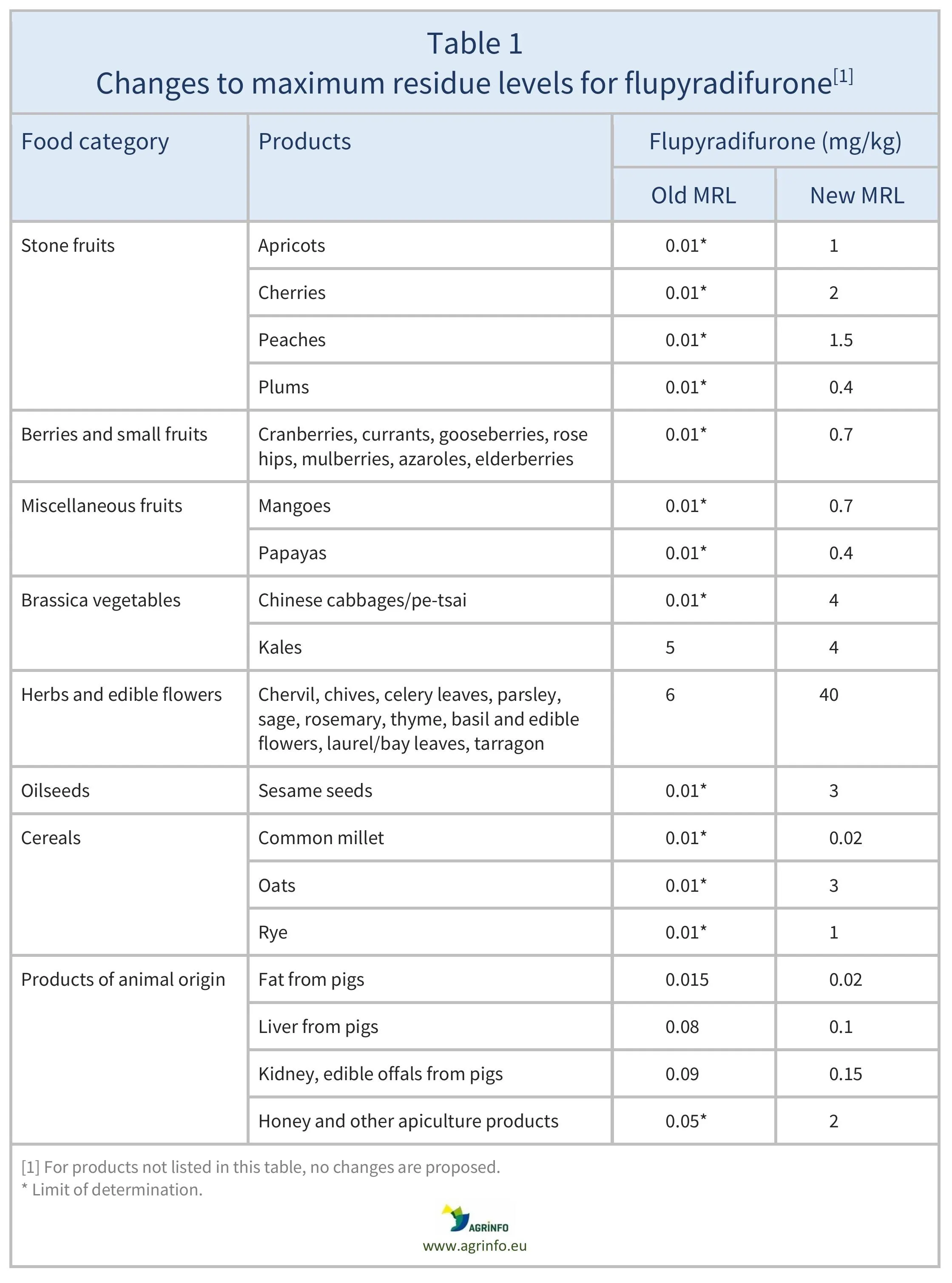Maximum residue levels for flupyradifurone
- Food safety
- Pesticide MRLs
- Pesticides
Summary
The European Commission has amended the maximum residue levels (MRLs) for flupyradifurone on certain stone fruits and other fruits, vegetables, cereals, and animal products.
EU aligns MRLs for flupyradifurone on pineapples and sunflower seeds with Codex standards
Commission Regulation (EU) 2025/581 of 27 March 2025 amending Annexes II and IV to Regulation (EC) No 396/2005 of the European Parliament and of the Council as regards maximum residue levels for cycloxydim, dichlorprop-P, flupyradifurone, methyl nonyl ketone, plant oils/citronella oil, potassium sorbate and potassium phosphonate in or on certain products
Commission Regulation (EU) 2024/2640 of 9 October 2024 amending and correcting Annex II to Regulation (EC) No 396/2005 of the European Parliament and of the Council as regards maximum residue levels for 1,4-dimethylnaphthalene, difluoroacetic acid (DFA), fluopyram and flupyradifurone in or on certain products
Update
The European Commission has amended the maximum residue levels (MRLs) for flupyradifurone on certain stone fruits and other fruits, vegetables, cereals, and animal products.
Impacted Products
Apricots, peaches, plums, cherries, cranberries, currants, gooseberries, rose hips, mulberries, azaroles, elderberries, mangoes, papayas, Chinese cabbages/ pe-tsai, kales, herbs and edible flowers, chervil, chives, celery leaves, parsley, sage, rosemary, thyme, basil and edible flowers, laurel/ bay leaves, tarragon, sesame seeds, sunflower seeds, common millet, oats, rye, fat, liver, kidney, edible offals from pigs, honey, pineapples
What is changing?
In October 2024 the European Union (EU) amended the MRLs for flupyradifurone as summarised in Table 1.
In March 2025 the EU introduced a further change, increasing the MRL for pineapples from 0.01 to 0.3 mg/kg, and for sunflower seeds from 0.7 to 0.8 mg/kg.
Why?
Following a request to review the MRLs for flupyradifurone and to set import tolerances, the European Food Safety Authority did not identify a consumer health risk (EFSA 2023). The EU has therefore adopted higher MRLs to avoid trade barriers when importing these crops.
In addition, the MRLs for flupyradifurone in pineapple and sunflower seeds have been updated to align the EU with the Codex MRL adopted in December 2023, as no consumer risk has been identified (Codex Alimentarius Commission 2023).
Timeline
The MRLs in Table 1 apply from 30 April 2025.
The new MRLs on pineapples and sunflower seeds apply from 17 April 2025.
Background
MRLs are set in accordance with the rules set out in Regulation 396/2005. For information on current MRLs for other substances, please consult the EU Pesticide Residues database.
Resources
EFSA (2023) Modification of the existing maximum residue levels and setting import tolerances for flupyradifurone and difluoroacetic acid (DFA) in various crops. EFSA Journal, 21(12): 8423.
Codex Alimentarius Commission (2023) MRLs FOR PESTICIDES IN FOOD AND FEED (AT STEPS 7 AND 4) Comments at Step 3 in reply to CL 2023/22-PR
Sources
Commission Regulation (EU) 2024/2640 as regards maximum residue levels for 1,4-dimethylnaphthalene, difluoroacetic acid (DFA), fluopyram and flupyradifurone in or on certain products
Commission Regulation (EU) 2025/581 as regards maximum residue levels for cycloxydim, dichlorprop-P, flupyradifurone, methyl nonyl ketone, plant oils/citronella oil, potassium sorbate and potassium phosphonate in or on certain products
Tables & Figures

Source: based on Regulation (EU) 2024/2640
Disclaimer: Under no circumstances shall COLEAD be liable for any loss, damage, liability or expense incurred or suffered that is claimed to have resulted from the use of information available on this website or any link to external sites. The use of the website is at the user’s sole risk and responsibility. This information platform was created and maintained with the financial support of the European Union. Its contents do not, however, reflect the views of the European Union.
EU aligns MRLs for flupyradifurone on pineapples and sunflower seeds with Codex standards
Commission Regulation (EU) 2025/581 as regards maximum residue levels for cycloxydim, dichlorprop-P, flupyradifurone, methyl nonyl ketone, plant oils/citronella oil, potassium sorbate and potassium phosphonate in or on certain products
Commission Regulation (EU) 2024/2640 as regards maximum residue levels for 1,4-dimethylnaphthalene, difluoroacetic acid (DFA), fluopyram and flupyradifurone in or on certain products
What is changing and why?
In October 2024, the EU amended the maximum residue levels (MRLs) for flupyradifurone on certain stone fruits and other fruits, vegetables, cereals, and animal products, as summarised in Table 1. This followed a request to modify the existing MRLs and set import tolerances in order to avoid trade barriers, where no consumer health risks have been identified.
In March 2025, the MRL for pineapple was updated from 0.01 to 0.3 mg/kg, and for sunflower seeds from 0.7 to 0.8 mg/kg, to align with the Codex MRL adopted in December 2023.
Timeline
The new MRLs in Table 1 apply from 30 April 2025.
The new MRLs for pineapple and sunflower seeds apply from 17 April 2025.
Tables & Figures

Source: based on Regulation (EU) 2024/2640
Disclaimer: Under no circumstances shall COLEAD be liable for any loss, damage, liability or expense incurred or suffered that is claimed to have resulted from the use of information available on this website or any link to external sites. The use of the website is at the user’s sole risk and responsibility. This information platform was created and maintained with the financial support of the European Union. Its contents do not, however, reflect the views of the European Union.
